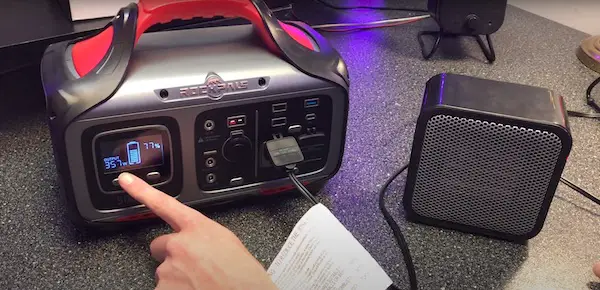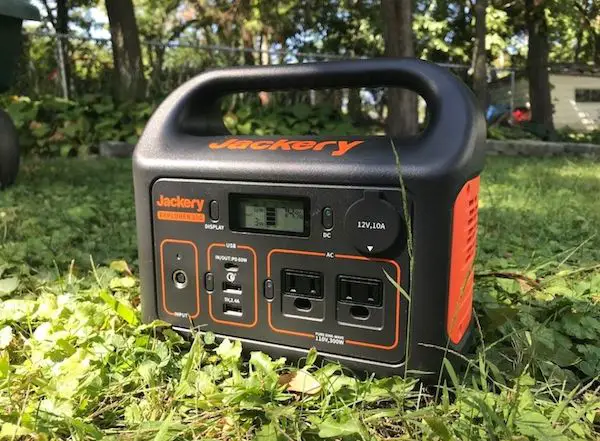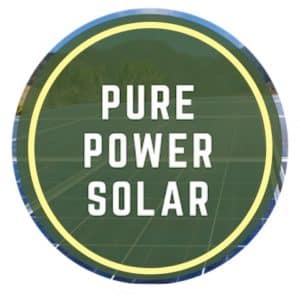Solar generators vary significantly both in their size and power output capabilities. This can be confusing if you’re trying to find out which ones can power your appliances successfully.
Appliances like space heaters consume a lot of energy, but they can have different power ratings depending on their size.
As a general rule, a solar generator with at least a 2,000W continuous output can run a 1,500W space heater. The generator’s run time depends on its battery capacity. For example, a Yeti 1500X is rated at 2,000W continuous with a 1,516Wh battery. It can run a 1,500W space heater for about an hour.
Solar generators rated under a 2,000W continuous output may struggle to power a 1,500W space heater since it can sometimes go over its rated wattage (especially when turning it to its highest temperature setting).
Pairing a solar generator with a space heater

There are several types of space heaters with different power ratings, so it’s important to check each one’s power output before using a solar generator to attempt to power it on.
You can find the space heater’s power rating on its product page, where it usually lists it in the product name or description. If you can’t find its rating in these areas, then see if you can find its user manual online. The manual usually has the product specifications laid out for you in there.
Once the output rating of the heater is found, then it’s time to find out what solar generators are ideal for it.
Another aspect that is as important as the output is the solar generator’s battery capacity. Since space heaters tend to use a lot of energy over time, they can drain smaller batteries quickly. For a heater that’s 1,000W, a 2,000Wh solar generator will barely be able to last two hours (if that) when using it.
1,000W (space heater) X 2 hours = 2,000Wh (battery capacity of the solar generator)
The more powerful the space heater is and the longer it runs, the bigger the battery you will need in addition to power output.
Below I have a table listing the ideal numbers to look for in a solar generator when comparing it to the ideal space heater for its specifications.
What portable power station will run a space heater?
The Bluetti AC300 portable power station can run a 1,500W space heater for about two hours. The Bluetti B300 is an expansion battery for the AC300 and doubles its capacity, allowing it to run the same 1,500W space heater for about four hours.
For a small space heater rated at 500W, the Jackery Explorer 1000 will run it for about two hours, whereas the Bluetti EB240 power station can run the same heater for about 4.5 hours.
Check out the table below for more recommendations.
| Space Heater Wattage | Recommended Solar Generator Continuous Output | Solar Generator Pairing (2+ hrs Run Time) | Ideal Solar Generator Battery Capacity (for 4+ hrs Run Time) | Solar Generator Pairing (4+ hrs Run Time) |
|---|---|---|---|---|
| 500W | 750-1,000W | Jackery Explorer 1000 | 2,000-2,500Wh | Bluetti EB240 |
| 750W | 1,000-1,500W | Bluetti EB150 | 3,000-3,500Wh | Goal Zero Yeti 3000X |
| 1,000W | 1,500-2,000W | Jackery Explorer 2000 | 4,000-4,500Wh | Point Zero Energy Titan x2 Batteries |
| 1,500W | 2,000-2,500W | Bluetti AC300 | 6,000-6,500Wh | Bluetti AC300 + B300 |
| 2,000W | 2,500-3,000W | Bluetti EP500Pro | 8,000-8,500Wh | EcoFlow Delta Pro + 2 Smart Extra Batteries |
Can the EcoFlow Delta power a heater?
The EcoFlow Delta 1300 can power a space heater rated for 1,500W for about 40 minutes before its battery is depleted. For a longer running time, a 500W heater can run for about two hours with the Delta 1300.
I calculated these estimates by taking 85% of its total battery capacity and dividing that number by the space heaters’ wattages. The 85% factors in the estimated inverter power consumption losses.
- Model: EcoFlow Delta 1300
- Battery Capacity: 1,260Wh
- Inverter Output: 1,800W continuous (3,300W surge)
Can a Jackery 1000 power an electric heater?
The Jackery 1000 can power an electric heater rated at 500-750W. Anything above 750W and you might risk overloading the Jackery’s 1,000W maximum continuous output. Using a 500W heater would be ideal because you can use some of the remaining power for additional needs.
In the table below, I have the estimated running times of using the Jackery 1000 with a 1,000W space heater, but this is a risky move due to the increased likelihood of overload.
Can a Jackery 500 power a space heater?
A Jackery 500 can power a space heater rated below 500W since its AC inverter is rated at 500W continuous. To prevent the possibility of exceeding the Jackery’s output level, it’s recommended to use a 400W space heater or smaller.
That being said, I’ve used the Rockpals Rockpower 500 to power my 500W space heater for about 30 minutes straight. The Rockpals 500 has the same inverter (continuous) rating as the Explorer 500, at 500W, and below you can see my video testing it out. I don’t recommend doing what I did in the video because I was testing it out and pushing the power station to its limits.
How long can a Jackery run a heater?

A Jackery Explorer 500 can run a 400W space heater for about 1-1.25 hours. It may struggle to run a 500W space heater, but if it can run it continuously, it’s estimated to last just under an hour.
A Jackery Explorer 1000 can run a 750W space heater for about 1-1.25 hours, a 500W heater for about 1.7-2 hours, and a 400W heater in the range of 2-2.5 hours.
The Jackery Explorer 1500 can power a 1,000W heater for about 1.25-1.5 hours and a 400W heater for roughly 3.25-3.65 hours.
The Jackery Explorer 2000 can run a 1,500W space heater for 1-1.25 hours, and with a 500W heater, it can run for an estimated 3.5-3.9 hours.
| Space Heater Wattage | Jackery 500 | Jackery 1000 | Jackery 1500 | Jackery 2000 |
|---|---|---|---|---|
| 1,500W | N/A | N/A | 52-58 mins* | 70-78 mins |
| 1,000W | N/A | 51-57 mins* | 78-87 mins | 105-117 mins |
| 750W | N/A | 68-76 mins | 104-117 mins | 140-156 mins |
| 500W | 53-59 mins* | 102-114 mins | 156-174 mins | 210-234 mins |
| 400W | 66-74 mins | 128-143 mins | 196-219 mins | 263-294 mins |
Will a generator run a small heater?
A generator will run a small heater as long as the generator’s running/continuous watts exceed the rated watts of the heater. Since the heater can sometimes exceed its rated watts, the ideal generator should have a continuous output roughly 200-500W higher than the heater to act as a buffer.
Best space heaters to use with solar generators
- Best all-around – Heat Storm Infrared Heater
- Best Value – andily Space Heater for Home and Office
- Best for small rooms – Amazon Basics Small Space Heater
- Best for desk tops – Brightown Mini Desk Heater
Below are the heaters from smallest to largest power output.
[table id=168 responsive=scroll /]
- Heat Storm infrared heater: The Heat Storm integrates with a smartphone app that lets you adjust settings over WiFi. It’s also the only one in this list that uses infrared heat (a form of radiant heat), which is more efficient than the convection heaters below.
- andily space heater: The price and power output options for this model make it ideal for use at home or in a cabin with a solar generator. It can switch between 750W and 1,500W, which allows you to turn the heat down once the room is warm and conserve energy.
- Amazon Basics space heater: I own this exact heater and it warms my small office nicely. It takes about 10-15 minutes to bring it from a chilly temperature (45-55 deg. F) to about 70-75 degrees F.
- Brightown mini desk heater: This heater can be effective for a small room and especially for a desk top when you’re working. Since it uses the least amount of energy (400W), it can last much longer than the other options when using it with a solar generator.
Safety Guidelines for Using Power Stations With Space Heaters
Like all electrical appliances, the use of space heaters with power stations requires precautionary measures to ensure safety. The following measures will ensure that the heater is powered safely without any damage to your health or property.
Ensure You Follow Wattage Ratings
Abiding by the wattage requirement will ensure that your power station or generator is not overloaded. It is advised that the output capacity of the power station is more than (preferably double) the wattage of the heater. This prevents potential damage to your solar generator to you yourself.
Most solar generators have an overload detection system that shuts the power station down when being overworked. This prevents any further damage to the power station.
It’s best to check for the wattage rating of your portable heaters in the manufacturer’s user manual. Most heaters have their wattage indicated on them – either on the back or bottom of the unit.
Place the Power Station & Space Heater Appropriately
A space heater should have at least three feet of space between any object that could be flammable. The power station should be placed as far away as possible from the heater’s heating element to prevent malfunction.
Portable power stations are already generating internal heat when they are powering your space heater, so avoiding any additional heat is the best practice.
For both the space heater and power station, avoid placing them near any water to prevent shock. If you’re using these appliances in a place like a shed or unfinished basement, make sure to check for potential leaks in the ceiling.
Conclusion
Space heaters can be powered by solar generators with the appropriate power output. The bigger the battery on the power station, the longer the heater will run.
Powering space heaters with solar generators as an alternative to gas generators has many advantages:
- Absence of fumes
- Very little noise when compared directly
- Completely off-grid capable
For more information on the differences between gas and solar generators, I recommend reading my article explaining the details here: Gas vs Solar Generators – Which Makes More Sense?
